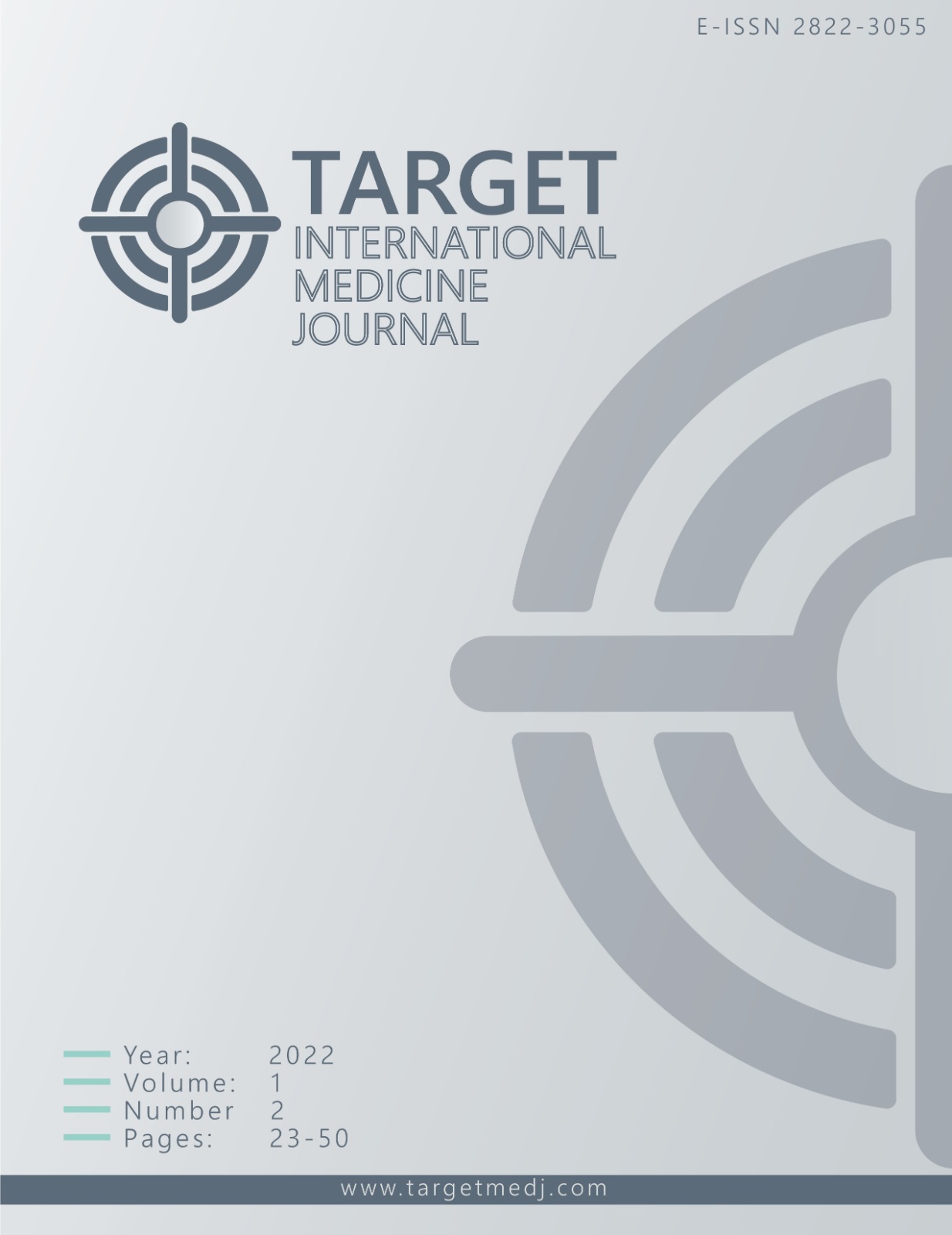Determination of oxidative stress level (malondialdehyde), some antioxidant activities (catalase and reduced glutathione) and IMA (Ischemia Modified Albumin) in gout patients
Author :
Abstract
Keywords
Abstract
Aim: The aim of this study was to determine the oxidative stress level and antioxidants such as malondialdehyde (MDA), reduced glutathione (GSH), ischemia modified albumin (IMA), catalase (CAT) and in patients with gout.
Materials and Methods: In the study, blood was collected from a total of 63 individuals, including 30 patients with gout and 33 healthy controls. MDA levels, IMA, GSH and CAT activities in blood serums were measured of patients and control group.
Results: CAT and GSH activity were low in gout patients, and MDA and IMA levels were statistically higher.
Conclusion: In conclusion, this study, low CAT and GSH activity, high MDA and IMA levels showed that oxidative stress may play an active role in patients with gout. Although our study is the first to determine the level of MDA, GSH, IMA and CAT activity in patients with gout, more comprehensive studies are needed to examine oxidative stress and antioxidant enzymes in patients with kidney disease, especially gout.
Keywords
- 1. Zhu Y, Pandya BJ, Choi HK. Prevalence of gout and hyperuricemia in the US general population: the National Health and Nutrition Examination Survey 2007--2008. Arthritis Rheum. 2011;63:3136-41.
- 2. Vargas-Santos AB, Neogi T. Management of gout and hyperuricemia in CKD. Am J Kidney Dis. 2017;70:422-39.
- 3. Schlesinger N. Diagnosing and treating gout: a review to aid primary care physicians. Postgrad. Med. 2010;122:157-61.
- 4. Martillo MA, Nazzal L, Crittenden DB. The crystallization of monosodium urate. Curr Rheumatol Rep. 2014;16:400.
- 5. Saigal R, Agrawal A. Pathogenesis and clinical management of gouty arthritis. J Assoc Physicians India. 2015;63:56-63.
- 6. Moolenburgh JD, Reinders MK, Jansen TLTA. Rasburicase treatment in severe tophaceous gout: a novel therapeutic option. Clin Rheumatol. 2006;25:749-52.
- 7. Wong ML. Optimal management of chronic gout: attempting to render the (t) issues crystal-clear. New Zeal Med J. 2005;118.
- 8. Young IS., Woodside, J. V, 2001. Antioxidants in health and disease. J. Clin. Pathol. 54, 176–186.
- 9. Droge W. Free radicals in the physiological control of cell function. Physiol. Rev. 2002;82:47-95.
- 10. Rahal A, Kumar A, Singh V, et al. Oxidative stress, proox- idants, and antioxidants: the interplay. Biomed Res Int 2014.
- 11. Kukongviriyapan U, Apaijit K, Kukongviriyapan V. Oxidative stress and cardiovascular dysfunction as-sociated with cadmium exposure: beneficial effects of curcumin and tetrahydrocurcumin. Tohoku J Exp Med. 2016;239:25-38.
- 12. Rao AL, Bharani M, Pallavi V. Role of antioxidants and free radicals in health and disease. Adv Phar-macol Toxicol 2006;7:29-38.
- 13. Islam MMT, Shekhar HU. Impact of oxidative stress on human health, in: Free Radicals in Human Health and Disease. Springer, 2015; pp. 59–73.
- 14. Özdem S, Çete Y, Dönmez L, et al. Serum levels of ischemia- modified albumin (IMA) in healthy adults and patients with acute coronary syndrome. Turkr J Emerg Med. 2005;5:169
- 15. Zurawska-Plaksej E, Grzebyk E, Marciniak D, et al. Oxidatively modified forms of albumin in patients with risk factors of metabolic syndrome. J Endocrinol Invest. 2014;37:819-27.
- 16. Fidan E, Menteşe A, Kavgacı H, et al. Increased ischemia- modified albumin levels in patients with gastric cancer. Neoplasma. 2012;59:393-7.
- 17. Aebi H. Catalase in vitro, in: Methods In Enzymology. Elsevier, 1984; p. 121-6.
- 19. Gutteridge JM. Lipid peroxidation and antioxidants as biomarkers of tissue damage. Clin. Chem. 1995;41:1819-28.
- 20. Sbarouni E, Georgiadou P, Voudris V. Ischemia modified albumin changes review and clinical implica-tions. Clin Chem Lab Me. 2011;49:177-84.
- 21. de Oliveira EP, Burini RC. High plasma uric acid concentration: causes and consequences. Dia-betology Metabolic Syndrome. 2012;4:1-7.
- 22. Jin M, Yang F, Yang I, et al. Uric acid, hyperuricemia and vascu-lar diseases. Frontiers in bioscience: a journal and virtual library. 2012;17:656.
- 24. Zeng J, Lawrence WR, Yang J, et al. Association between serum uric ac-id and obesity in Chinese adults: a 9-year longitudinal data analysis. BMJ open. 2021;11:e041919.
- 26. Ratliff BB, Abdulmahdi W, Pawar R, Wolin MS. Oxidant mechanisms in renal injury and disease. Antioxidants Redox Signaling. 2016;25:119-46.
- 27. Nkeck JR, Ngandeu MS, Moor VA, et al. Acute Gout Attack in Came-roonians and Oxidative Stress: Cause and Effect. J Autoimmune Disord. 2017;3:42.
- 28. Acharya C, Sharma A, Kantharia ND. Involvement of oxidative stress in patients of gout and anti-oxidant effect of allopurinol. Int J Med Sci Public Health. 2015;4:168-72.
- 29. Mylonas C, Kouretas D. Lipid peroxidation and tissue damage. In Vivo (Athens, Greece). 1999;13:295-309.
- 30. Dolphin D, Poulson R, Avramovic, O. Glutathione: chemical, biochemical, and medical aspects. New York: Wiley. 1989;3.
- 31. Chawla R, Goyal N, Calton R, Goyal S. Ischemia modified albumin: A novel marker for acute cor-onary syndrome. Indian Journal of Clinical Biochemistry. 2006;21:77-82.
- 32. Sbarouni E, Georgiadou P, Kremastinos DT, Voudris V. Ischemia modified albumin: is this marker of ischemia ready for primetime use. Hellenic J Cardiol. 2008;49:260-6.
- 35. Hitchon, CA, El-Gabalawy, HS. Oxidation in rheumatoid arthritis. Arthritis Res Ther. 2004;6:1-14.
- 36. Christen, Y. Oxidative stress and Alzheimer disease. Am J Clin Nutrition. 2000;71:621-9.
